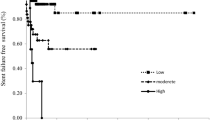Abstract
Objective
To determine the potential predictors of antegrade ureteral stenting (AUS) failure in patients with malignant and benign ureteral obstruction.
Method
We retrospectively evaluated 116 AUS procedures performed in 80 patients for ureteral obstruction due to malignant and benign causes. Variables such as etiology for obstruction, ureter shape, previous treatment regimen, history of ileal loop diversion, and presence of percutaneous nephrostomy were recorded. Univariate and multivariate logistic regression methods were used between these variables and stent failure.
Results
Antegrade ureteral stenting was performed as single stage in 24 procedures (n: 24/116, 21%) and performed as a two-step approach after percutaneous nephrostomy in 92 procedures (n: 92/116, 79%). Ureteral stent was successfully deployed in 112 AUS procedures (n: 112/116, 96.5%). In 35 of these successful procedures, the patients were referred to our department due to prior failed retrograde ureteral stenting (RUS). Subsequent stent failure occurred in 40 procedures after a median interval of 39 days. Pre-stenting percutaneous nephrostomy (PN) was a statistically significant risk factor for stent failure (p: 0.041), and age showed an inverse relationship with stent failure (p: 0.008). Complications in early (within the first 30 days after procedure) and late stage occurred in a total of 17 procedures. Early complications included urinary tract infection (n: 11), stent migration (n: 3), and malposition (n: 1). Late complications (after 30 days) were urinary tract infection (n: 1) and stent migration (n: 1).
Conclusion
This study suggests that AUS can be performed effectively in both benign and malignant ureteral obstructions including cases with prior failed RUS. Two-step AUS after percutaneous nephrostomy was found to be a significant risk factor for subsequent stent failure in our study cohort.


Similar content being viewed by others
References
Lynch, Mark F., et al. “Current opinion amongst radiologists and urologists in the UK on percutaneous nephrostomy and ureteric stent insertion for acute renal unobstruction: Results of a postal survey.” BJU International 98.6 (2006): 1143-1144.
Hsu, Linda., et al. “Use of percutaneous nephrostomy and ureteral stenting in management of ureteral obstruction.” World Journal of Nephrology 5.2 (2016): 172-181.
Chitale, S. V., et al. “The management of ureteric obstruction secondary to malignant pelvic disease.” Clinical Radiology 57.12 (2002): 1118-1121.
Kim, Sung Han., et al. “Retrograde pyelography predicts retrograde ureteral stenting failure and reduces unnecessary stenting trials in patients with advanced non-urological malignant ureteral obstruction.” PloS One 12.9 (2017): e0184965.
Ganatra, Anjali M., et al. “The management of malignant ureteral obstruction treated with ureteral stents.” The Journal of Urology 174.6 (2005): 2125-2128.
Hausegger, Klaus Armin., et al. “Percutaneous nephrostomy and antegrade ureteral stenting: technique—indications—complications.” European Radiology 16.9 (2006): 2016-2030.
Dyer, Raymond B., et al. “Complications of ureteral stent placement.” Radiographics 22.5 (2002): 1005-1022.
Nguyen, Hiep T., et al. “The Society for Fetal Urology consensus statement on the evaluation and management of antenatal hydronephrosis.” Journal of Pediatric Urology, 6.3 (2010): 212-231.
Matsuura, Hiroshi., et al. “Ureteral stents for malignant extrinsic ureteral obstruction: outcomes and factors predicting stent failure.” International Journal of Clinical Oncology 24.3 (2019): 306-312.
Kamiyama, Yoshihiro., et al. “Stent failure in the management of malignant extrinsic ureteral obstruction: risk factors.” International Journal of Urology 18.5 (2011): 379-382.
Yossepowitch, Ofer., et al. “Predicting the success of retrograde stenting for managing ureteral obstruction.” The Journal of Urology 166.5 (2001): 1746-1749.
van der Meer, Rutger W., et al. “Antegrade ureteral stenting is a good alternative for the retrograde approach.” Current Urology 10.2 (2017): 87-91.
Turgut, B., et al. “Placement of double-J stent in patients with malignant ureteral obstruction: antegrade or retrograde approach?” Clinical Radiology 74.12 (2019): 976.e11-976.e17.
Kahriman, Guven., et al. “Percutaneous antegrade ureteral stent placement: single center experience.” Diagnostic and Interventional Radiology 25.2 (2019): 127-133.
Bahu, Ramez., et al. “Nephrostomy tube related pyelonephritis in patients with cancer: epidemiology, infection rate and risk factors.” The Journal of Urology 189.1 (2013): 130-135.
Chung, Steve Y., et al. “15-year experience with the management of extrinsic ureteral obstruction with indwelling ureteral stents.” The Journal of Urology 172.2 (2004): 592-595.
Izumi, Kouji., et al. “Current outcome of patients with ureteral stents for the management of malignant ureteral obstruction.” The Journal of Urology 185.2 (2011): 556-561.
Yu, Seong Hyeon., et al. “Predicting factors for stent failure-free survival in patients with a malignant ureteral obstruction managed with ureteral stents.” Korean Journal of Urology 54.5 (2013): 316-321.
Uthappa, M. C., et al. “Retrograde or antegrade double-pigtail stent placement for malignant ureteric obstruction?” Clinical Radiology 60.5 (2005): 608-612.
Funding
None to declare.
Author information
Authors and Affiliations
Corresponding author
Ethics declarations
Conflict of interest
All authors state that they have no conflict of interest to declare.
Ethical approval
All procedures followed were in accordance with the ethical standards of the responsible committee on human experimentation (institutional and national). This study was approved by the institutional ethics review of board.
Informed consent
All patients participating in the study have provided informed consent.
Additional information
Publisher's Note
Springer Nature remains neutral with regard to jurisdictional claims in published maps and institutional affiliations.
Rights and permissions
About this article
Cite this article
Nas, O.F., Oztepe, M.F., Kandemirli, S.G. et al. Predictors of antegrade ureteral stenting failure: a single-center experience in patients with malignant and benign ureteral obstruction. Abdom Radiol 46, 2188–2194 (2021). https://doi.org/10.1007/s00261-020-02858-z
Received:
Revised:
Accepted:
Published:
Issue Date:
DOI: https://doi.org/10.1007/s00261-020-02858-z




